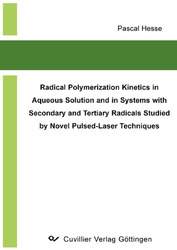| Departments | |
|---|---|
| Book Series (96) |
1377
|
| Nachhaltigkeit |
3
|
| Gesundheitswesen |
1
|
| Humanities |
2361
|
| Natural Sciences |
5403
|
| Mathematics | 229 |
| Informatics | 318 |
| Physics | 979 |
| Chemistry | 1362 |
| Geosciences | 131 |
| Human medicine | 243 |
| Stomatology | 10 |
| Veterinary medicine | 108 |
| Pharmacy | 147 |
| Biology | 835 |
| Biochemistry, molecular biology, gene technology | 121 |
| Biophysics | 25 |
| Domestic and nutritional science | 45 |
| Agricultural science | 1004 |
| Forest science | 201 |
| Horticultural science | 20 |
| Environmental research, ecology and landscape conservation | 148 |
| Engineering |
1788
|
| Common |
97
|
|
Leitlinien Unfallchirurgie
5. Auflage bestellen |
|
Advanced Search
Radical Polymerization Kinetics in Aqueos Solution and in Systems with Secondary and Tertiary Radicals Studied by Novel Pulsed- Laser Techniques (English shop)
Pascal Hesse (Author)Preview
Abstract
Rate coefficients of propagation, kp, of termination, kt, and of intramolecular transfer-to-polymer, kbb, have been studied via pulsed-laser polymerization (PLP) methods for systems with strong intermolecular interactions, such as hydrogen bonds, and for polymerizations with two types of distinctly different radicals being present.
The propagation kinetics of methacrylic acid (MAA) and N-vinyl pyrrolidone (NVP) in aqueous solution has been investigated by the PLP-SEC technique which combines PLP-initiation with subsequent analysis of the produced polymer by size-exclusion chromatography. The experimental conditions of monomer concentration, temperature, pressure and degree of monomer ionization have been varied in wide ranges. The dependence of kp on monomer-to-polymer conversion has been determined from PLP-SEC experiments with pre-mixed polymer. The variation of kp may be adequately explained by the interaction of solvent and monomer molecules with the transition state structure for propagation. The termination rate coefficients of MAA and NVP have been studied by the SP PLP NIR method in which the change in monomer concentration after single pulse (SP) initiation is monitored via s time-resolved near infrared spectroscopy (NIR). The variations of kt with conversion for different initial monomer concentrations reflect the diffusion-controlled character of the termination step with kt being governed by segmental, translational, and reaction diffusion.
In acrylate polymerization backbiting reactions may occur by which chain-end secondary propagating radicals (SPR) are transformed into tertiary midchain radicals (MCR) via 1,5-hydrogen shift. MCRs can react back to SPRs by monomer addition. The basic kinetic scheme has to be extended for additional reactions steps, as SPR and MCR species show widely different kp and kt, respectively. The impact of MCR formation on the applicability of the experimental techniques for kp and kt determination, i.e. PLP-SEC and SP-PLP-NIR, was investigated by PREDICI simulations. A novel experimental method has been developed by which kbb and the rate coefficient for monomer addition to the MCR, kpt, for butyl acrylate (BA) have been determined from PLP-SEC experiments carried out under extended variation of laser pulse repetition rates. Insights into the kinetics, especially of the termination reactivity of secondary and tertiary acrylate radicals, have been obtained by measurements of full electron spin resonance (ESR) spectra under stationary UV and pseudo-stationary PLP initiation, respectively, or by time-resolved monitoring of SPR and MCR concentrations after application of a laser single pulse (SP-PLP-ESR). By the latter technique also chain-length-dependent individual kt values are accessible.
For acrylic acid (AA) polymerization in aqueous solution, the complexities associated with strong solvent effects on the rate coefficients and with the pronounced MCR build-up add to each other. Attempts were made to consider the resulting consequences for the kinetic data of AA polymerization in aqueous solution published so far.
| ISBN-13 (Printausgabe) | 386727682X |
| ISBN-13 (Hard Copy) | 9783867276825 |
| ISBN-13 (eBook) | 9783736926820 |
| Language | English |
| Page Number | 326 |
| Edition | 1 Aufl. |
| Volume | 0 |
| Publication Place | Göttingen |
| Place of Dissertation | Göttingen |
| Publication Date | 2008-08-08 |
| General Categorization | Dissertation |
| Departments |
Chemistry
|
| Keywords | acrylic acid, backbiting, butyl acrylate, free-radical polymerization, methacrylic acid, midchain radicals, modeling, N-vinyl pyrrolidone, PLP-SEC, propagation kinetics, pulsed-laser initiation, termination kinetics, SP-PLP-ESR, SP-PLP-NIR, transfer kinetics |








